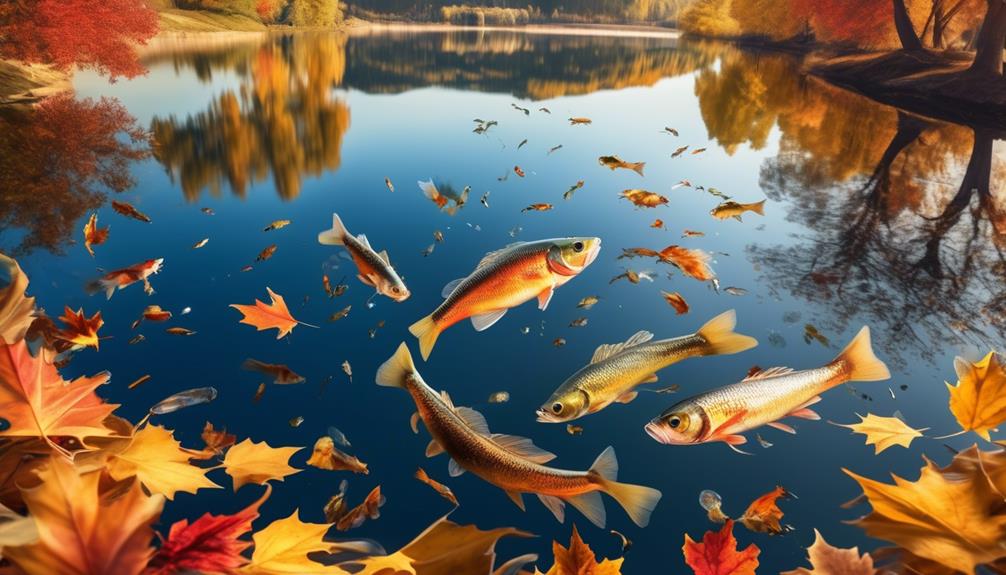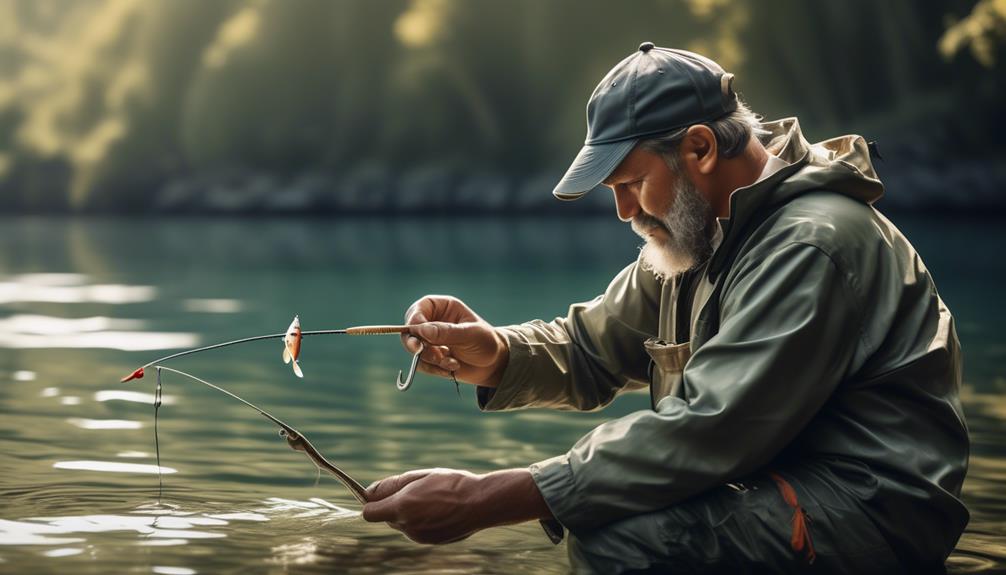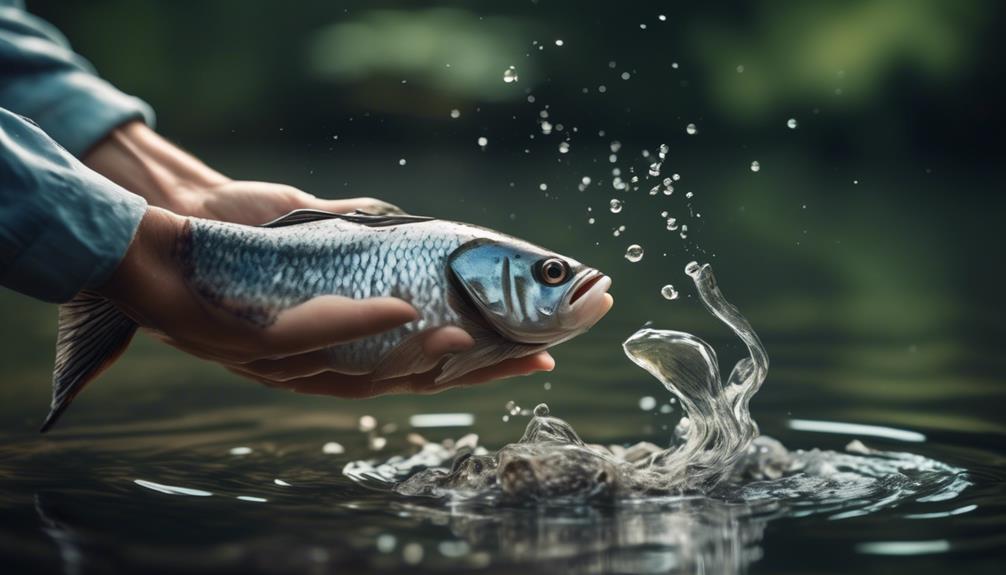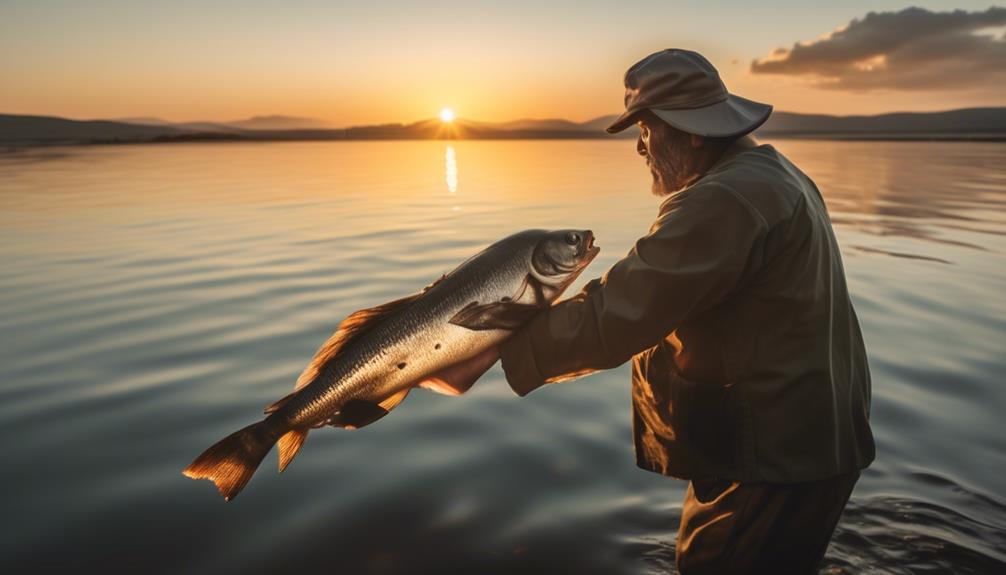You may have noticed that catch and release fishing can be affected by seasonal changes. As you head out to your favorite fishing spot, you might have experienced variations in the success of catching and releasing fish throughout the year.
But have you ever wondered why this happens? There are several factors at play that can significantly impact the effectiveness of catch and release fishing, and understanding these seasonal influences can greatly enhance your angling experience.
Spring Catch and Release Fishing
In spring, avid anglers eagerly await the opportunity to engage in catch and release fishing as the waters begin to warm and the fish become more active. During this season, fish populations exhibit spawning behavior, leading to an increase in their activity levels. This makes them more susceptible to biting, providing anglers with an ideal opportunity for catch and release fishing.
As the weather warms and aquatic insect hatches become more prevalent, fish feeding habits undergo a significant change. This shift in feeding behavior presents a unique challenge for anglers, who must adapt their techniques to match the preferences of the fish. Understanding the specific insects that are hatching and the feeding patterns of the fish is crucial for successful catch and release fishing during this time.
Spring also marks the beginning of a period where various fish species migrate to shallower waters and areas with suitable spawning conditions. This natural movement of fish populations contributes to an increased likelihood of successful catches for anglers. However, it's essential to exercise responsible fishing practices, especially during spawning seasons, to ensure the sustainability of fish populations.
Summer Catch and Release Fishing
The summer months bring about a shift in fishing conditions, impacting catch and release techniques for anglers. As the water temperature rises, fish behavior changes, making it crucial to adjust your approach for successful catch and release during this season.
Summer is the time when many fish species spawn, making it essential to handle them with extra care. During spawning, fish are more vulnerable and easily stressed, so it's important to minimize handling and release them quickly to ensure their well-being. By using barbless hooks and practicing proper catch and release methods, you can help protect spawning fish populations and contribute to sustainable fishing practices.
Additionally, summer brings about a flurry of insect hatches, providing abundant food sources for fish. To improve your catch and release success, it's essential to match your fly patterns to the prevalent insects. By observing the insect activity around the water and adjusting your fishing techniques accordingly, you can increase your chances of a successful catch while minimizing stress on the fish.
When handling fish during the summer, it's crucial to keep the fish in the water as much as possible, especially when unhooking and releasing them. This helps maintain their oxygen levels and reduces the risk of injury.
Fall Catch and Release Fishing
As autumn arrives, adjusting your catch and release approach becomes essential due to changing water temperatures and fish behavior. During fall, the cooling water temperatures trigger significant shifts in fish activity. The changing colors of the leaves signal a drop in water temperatures, which can lead to a decrease in fish metabolism. This means that fish may be less active and more selective in their feeding habits.
Therefore, adjusting your bait and presentation to match the changing behavior of the fish is crucial. Fish migration also plays a crucial role in fall catch and release fishing. Many species of fish, such as salmon and trout, undertake migratory journeys during this time, making it important to understand their movements for successful catch and release.
As the foliage changes, it's a visual reminder that nature is transitioning, and so should your fishing strategies. Additionally, as fish migrate to their spawning grounds, it's essential to be aware of any regulations or restrictions in place to protect these vulnerable populations.
Understanding the impact of foliage changes and fish migration on fall catch and release fishing is vital for maintaining the health of fish populations. By adapting your techniques to suit the changing behavior of fish and respecting their migratory patterns, you can continue to enjoy the sport of fishing while preserving the aquatic ecosystem.
Winter Catch and Release Fishing
Adjusting your catch and release techniques for winter fishing becomes crucial as water temperatures continue to drop, impacting fish behavior and activity levels. In cold weather, certain fish species remain more active and are accessible for ice fishing. When engaging in catch and release during winter, it's essential to be mindful of the specific techniques that are best suited for this season.
Ice fishing presents a unique opportunity for catch and release during winter. As the water freezes over, it allows anglers to access fish that may not have been as easily reachable during other seasons. When ice fishing, it's important to use the right gear and techniques to ensure the safety and well-being of the fish. Specialized equipment, such as ice augers and tip-ups, are commonly used for ice fishing. Additionally, it's crucial to drill holes carefully and handle the fish gently to minimize stress and injury during the release process.
In winter, certain fish species, such as trout and walleye, remain active and can be targeted for catch and release. Understanding the behavior and preferences of these fish during cold weather is essential for successful catch and release. Adjusting your bait and lures to match the feeding patterns of these species can increase your chances of a successful release.
Weather Conditions and Fishing Success
To maximize your fishing success, understanding how weather conditions impact fish behavior and activity levels is crucial.
Temperature fluctuations play a significant role in determining fish activity. As temperatures rise, fish become more active, feeding more frequently and moving into shallower waters. Conversely, during temperature drops, fish activity tends to slow down, and they may seek deeper, warmer areas to conserve energy.
As an angler, being aware of these temperature patterns can help you adjust your fishing strategy accordingly.
Weather patterns also have a direct impact on fish behavior and, consequently, on angler strategy. For example, low-pressure systems often result in overcast skies and precipitation, which can lead to increased fish activity. Fish are typically more active during these conditions, as reduced sunlight and oxygen levels trigger them to search for food more actively.
Conversely, high-pressure systems usually bring clear skies and stable conditions, which can make fish more cautious and less inclined to feed. Understanding these weather patterns allows you to anticipate fish behavior and adjust your angling techniques accordingly.
Ultimately, being mindful of temperature fluctuations and weather patterns can greatly enhance your fishing success. By incorporating this knowledge into your angling strategy, you can position yourself for a more productive and rewarding fishing experience.
Impact of Water Temperature on Fish Behavior
Understanding how water temperature affects fish behavior is crucial for any angler looking to improve their catch rate. Fish metabolism is greatly influenced by water temperature. As the temperature changes, so does the metabolic rate of fish. In warmer waters, fish metabolism speeds up, causing them to become more active and requiring more food. Conversely, in colder waters, fish metabolism slows down, leading to decreased activity and a reduced need for sustenance. This directly impacts their feeding patterns and overall behavior.
Temperature gradients in bodies of water also play a significant role in fish behavior. Fish tend to seek out areas with water temperatures that are most suitable for their metabolic needs. For instance, during warmer months, you're more likely to find fish in shallower areas where the water is warmer. In contrast, during colder seasons, fish may move to deeper parts of the water where the temperature is more stable and suitable for their slowed metabolism.
Effect of Changing Fish Feeding Patterns

Fish feeding patterns shift in response to changes in water temperature, affecting their activity levels and foraging behavior. As water temperature fluctuates, so do the feeding habits of fish. When the water is warmer, fish tend to be more active and have higher metabolic rates, leading to increased feeding behavior. Conversely, colder water temperatures can slow down fish metabolism, causing them to feed less frequently and be less active overall. These changing fish behaviors have a significant impact on catch and release fishing.
Understanding the effect of changing fish feeding patterns is crucial for anglers. As fish alter their foraging behavior based on water temperature, it becomes essential to adapt fishing techniques and bait choices accordingly. During periods of increased feeding activity, anglers may find more success using fast-moving lures or live bait to entice bites from actively feeding fish. Conversely, when fish are less active due to colder water temperatures, using slower presentations and adjusting bait choices to match their reduced feeding habits can improve fishing outcomes.
Furthermore, recognizing the impact of changing fish feeding patterns can lead to more sustainable catch and release practices. When fish are less actively feeding, they may be less likely to aggressively strike at bait, reducing the risk of deep hooking and potential harm to the fish. By aligning fishing practices with the natural shifts in fish feeding behavior, anglers can minimize stress on fish populations and contribute to conservation efforts.
Considerations for Fishing Regulations by Season
Considering seasonal variations in fish behavior and population dynamics is essential when formulating fishing regulations to promote sustainable angling practices. As you explore the impact of seasonality on catch and release fishing, it's crucial to consider the following factors for fishing regulations by season:
- Environmental Impact: Different seasons can greatly affect the natural habitat of fish, influencing their behavior and reproductive patterns. Fishing regulations need to be tailored to minimize disruption to the environment during sensitive periods such as spawning seasons. By adjusting regulations accordingly, you can help maintain the ecological balance and protect the overall health of aquatic ecosystems.
- Population Dynamics: Fish populations fluctuate throughout the year due to factors like migration, spawning, and feeding patterns. Understanding these fluctuations is vital for setting regulations that support sustainable fish populations. By implementing seasonal restrictions on catch limits or specific fishing methods, you can contribute to the preservation of fish stocks and ensure their long-term viability.
- Conservation Efforts: Seasonal variations can impact the success of conservation efforts aimed at protecting vulnerable species. Fishing regulations should align with these efforts, offering additional protections during critical periods to aid in the recovery of endangered or threatened fish species.
- Socioeconomic Considerations: Recognizing the socioeconomic impact of seasonal fishing regulations is also crucial. Balancing conservation needs with the interests of local communities and fishing industries ensures that regulations aren't only environmentally sound but also socially sustainable.
Frequently Asked Questions
Can the Type of Bait Used for Catch and Release Fishing Change Depending on the Season?
Depending on the season, the type of bait used for catch and release fishing can definitely change. Seasonal bait can be more effective at different times of the year due to varying weather conditions and water temperature.
For example, in warmer months, using bait that mimics insects or other natural prey can be more successful. This is because warmer weather often means increased activity among fish and a higher likelihood of them feeding on smaller creatures.
On the other hand, in colder months, using bait that appeals to fish in hibernation mode may be more effective. During this time, fish may be less active and less likely to chase after fast-moving bait. Instead, using slow-moving or stationary bait that is easy for fish to access and consume can yield better results.
It is important for anglers to be aware of these seasonal changes and adjust their bait selection accordingly. By doing so, they can increase their chances of successfully catching and releasing fish throughout the year.
How Does Fish Migration Patterns Affect Catch and Release Fishing During Different Seasons?
Fish behavior and migration patterns have a significant impact on catch and release fishing during different seasons.
Environmental factors, such as water temperature and food availability, influence fish movement.
In the spring, many fish species migrate to shallower waters for spawning, making them more accessible to anglers.
In contrast, during the fall, fish may move to deeper waters or exhibit different feeding behaviors, affecting the success of catch and release fishing.
Are There Specific Fish Species That Are More Active During Certain Seasons for Catch and Release Fishing?
Certain fish species exhibit specific behavioral patterns tied to seasonal changes, impacting catch and release fishing. Environmental factors such as water temperature and daylight influence fish behavior, leading to increased activity during certain seasons.
Understanding these seasonal patterns can aid in targeting specific species more effectively. For example, in warmer months, bass tend to be more active, making them a prime target for catch and release fishing.
How Does the Duration of Daylight Impact Catch and Release Fishing in Different Seasons?
During different seasons, the duration of daylight impacts catch and release fishing. The effect of temperature on catch and release fishing changes with daylight hours. Warmer temperatures during longer days can increase fish activity.
Weather also influences catch and release fishing techniques, affecting fish behavior and feeding patterns. Understanding the impact of daylight duration on fishing can help adjust your strategies for a successful catch and release experience.
Are There Specific Techniques or Strategies That Should Be Used for Catch and Release Fishing in Each Season?
In catch and release fishing, specific techniques and strategies should be used for each season. Environmental impact and angler responsibility are crucial factors to consider.
You must adapt your approach based on the changing conditions such as water temperature, fish behavior, and spawning patterns.
In spring, focus on protecting spawning grounds, while in summer, pay attention to keeping fish cool and hydrated.
In fall, be mindful of the changing feeding patterns, and in winter, prioritize minimizing stress on fish.
Conclusion
In conclusion, seasonality impacts catch and release fishing in various ways.
From changes in fish behavior and feeding patterns to the impact of weather conditions and water temperature, it's important to consider these factors when planning your fishing trips.
Understanding how different seasons affect fishing can help you adapt your techniques and improve your chances of success.
So, next time you head out for catch and release fishing, keep in mind the seasonal differences and adjust your approach accordingly.
Happy fishing!



